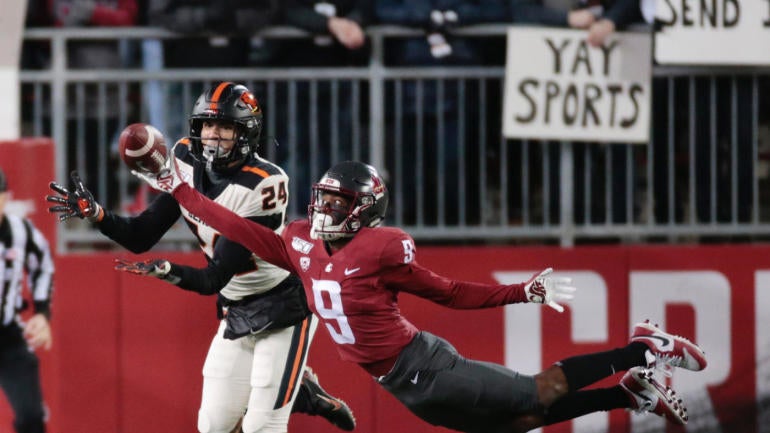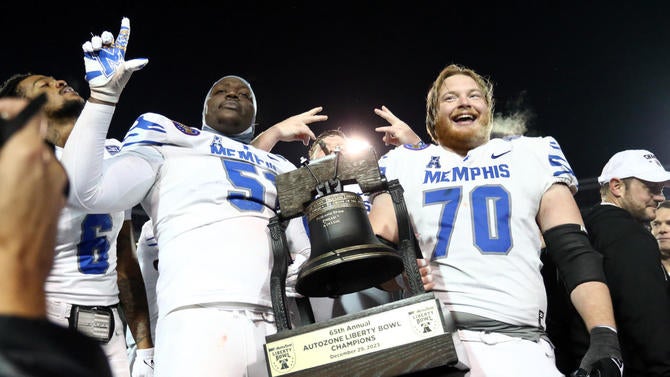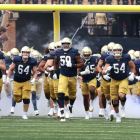
When the music stopped in the most recent round of conference realignment musical chairs, Oregon State and Washington State had nowhere to go after the Pac-12 imploded.
Ten schools grabbed chairs, even ones that didn't make any geographical sense in the case of Cal and Stanford in the Atlantic Coast Conference, but the two Pacific Northwest schools had no viable option within the Power Five ranks.
Now, the last remnants of a historic conference have created the next disturbance in the college athletics space themselves. Oregon State and Washington State saw no choice but to inflict on other schools the trauma they've experienced the last year-plus in a Darwinian pursuit of survival.
For the Pac-12 to survive, it needed confusion, disarray and disorder to reign again in college sports.
"Chaos, right now, is opportunity," Anne McCoy, the 56-year-old Washington State AD, told CBS Sports on Wednesday, hours before news broke of the Pac-12's plan to add Boise State, San Diego State, Colorado State and Fresno State.
Oregon State athletic director Scott Barnes similarly told CBS Sports Wednesday he was hoping for more disruption in college athletics because "the most logical opportunity for us is if there is continued movement in the marketplace some time in the future that allows us to move into a Power 5 situation."
Less than twelve hours later, McCoy and Barnes' intentions became clear.
Yahoo Sports broke the news late Wednesday night that Oregon State and Washington State had targeted Boise State, San Diego State, Colorado State and Fresno State from the Mountain West to refill the Pac-12's depleted ranks. The news was announced as official on Thursday morning. The Beavers and Cougars are poaching the Mountain West's premier properties after they couldn't reach an agreement with the conference on an extension of a scheduling agreement.
In the modern realignment era, Oregon State and Washington State are the only two Power Five schools never to find a conference home. There had been speculation the pair hoped to one day get an ACC invite like Cal and Stanford, but this week's news revealed they view the best, perhaps only, way forward as rebuilding the Pac-12. It comes with challenges, but will certainly make scheduling easier after the pair has essentially been de facto FBS independents this season after playing together in what used to be known as the Pac-12 for decades.
The news comes days before the latest editions of two storied West Coast rivalries that all involved fought hard to preserve in the face of hurt feelings and internal pressure. Conference realignment has been particularly unkind to treasured rivalries, with the allure of more television money far outstripping the games fans care most about in the decision-making process. In recent years, realignment killed Kansas-Missouri (in football) and Texas-Texas A&M (since restored in the SEC). Duke still hasn't played Maryland in basketball since it left the ACC for the Big Ten in 2014.
The same could have been the case -- perhaps was even likely to be the case, at times -- after Oregon State and Washington State were left behind.
"High stakes, emotions run high," Barnes said. "Many of our fanbase did not want to play it again out of the gate."
That the Civil War (Oregon-Oregon State) and Apple Cup (Washington-Washington State) are played again on Saturday, the first time since Oregon and Washington ditched their in-state rivals for the Big Ten's riches, is in many ways remarkable. The two Pac-12 castoffs found a way to continue playing against their fiercest rivals, at least in the short term, when it would have been easier to be bitter and petty and let the cherished rivalry games die like so many had before it at the hands of realignment.
"The will to keep a 130-year rivalry alive at a time when there's changes occurring in college athletics by the day," Barnes said. "This particular game is, in a lot of ways, good medicine."
Now it's about climbing the steps back to play on the biggest stage possible. Said Barnes: "It's [about] staying relevant."
Relevancy may be on its way. The two schools are armed with a $250 million war chest left from Pac-12 distributions that could fund the exit fees of those MW schools.
It starts with chaos, or at least the hope of it.
"It's kind of a double-edged sword because early on it doesn't feel great so the thought of other people going through it," McCoy said Wednesday as her voice trailed off. "But I think in this case it might be self-imposed chaos so it's a conscious choice people are making which is maybe a little different and how they're impacted.
"Chaos certainly helps because it creates opportunity."
Pac-12 commissioner Teresa Gould still needs to add two more schools to reach the NCAA minimum of eight to maintain the Pac-12 past 2026. Sources told CBS Sports that schools west of the Mississippi in the American Athletic Conference could be targeted. That list could include some combination of UTSA, Rice and North Texas, as well as Memphis. If the new, six-school Pac-12 wanted to raid the Mountain West again, Air Force and UNLV would be two obvious options, too.

The impending departures of Boise State, Colorado State, Fresno State and San Diego State throw the Mountain West into chaos. The remaining eight schools would have to re-trench with the MWC's current contract with CBS and Fox ending after the 2025 football season. Either that or the eight schools would scatter to the four winds, seeking other conferences. The Mountain West's current deal with CBS Sports and Fox Sports pays it approximately $45 million per year.
The Mountain West finds itself in a place Oregon State and Washington State know well. Not only will the remaining Mountain West schools face the stress of trying to navigate a path forward in turbulent times, but will read all the obituaries of the conference that are soon to come. It was beyond awkward for Oregon State and Washington State last year as the outgoing schools, media and others proclaimed it the final year of the Pac-12. Even in internal Pac-12 coaches meetings, the outgoing coaches called it the last year of the conference, much to the chagrin of the OSU and WSU coaches in attendance.
"It's like somebody deciding to move and assuming you're selling the house," McCoy said. "Just because you're moving doesn't mean everything is automatically going to shutter on June 30, 2024."
It didn't and now the mostly abandoned Pac-12 block is growing with incoming neighbors. This is the chaos Oregon State and Washington State wanted, with the ripples across the sport just beginning to be felt.
















